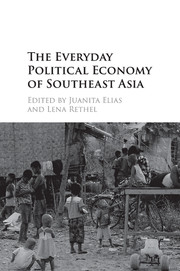Book contents
- Frontmatter
- Epigraph
- Contents
- List of Figures and Map
- List of Tables
- Notes on Contributors
- Acknowledgements
- Part I Introduction
- Part II From Development to Multiple Modernities
- Part III Widening and Deepening Markets
- Part IV People, Mobilities and Work
- 8 From Formal Employment to Street Vending: Malaysian Women's Labour Force Participation over the Life Course
- 9 Everyday Identities in Motion: Situating Malaysians within the ‘War for Talent’
- 10 Regional Disputes over the Transnationalization of Domestic Labour: Malaysia's ‘Maid Shortage’ and Foreign Relations with Indonesia and Cambodia
- 11 Enforcing Socioeconomic Rights: Everyday Agency, Resistance and Community Resources among Indonesian Migrant Domestic Workers in Hong Kong
- Part V Conclusion
- Index
- References
8 - From Formal Employment to Street Vending: Malaysian Women's Labour Force Participation over the Life Course
from Part IV - People, Mobilities and Work
Published online by Cambridge University Press: 05 August 2016
- Frontmatter
- Epigraph
- Contents
- List of Figures and Map
- List of Tables
- Notes on Contributors
- Acknowledgements
- Part I Introduction
- Part II From Development to Multiple Modernities
- Part III Widening and Deepening Markets
- Part IV People, Mobilities and Work
- 8 From Formal Employment to Street Vending: Malaysian Women's Labour Force Participation over the Life Course
- 9 Everyday Identities in Motion: Situating Malaysians within the ‘War for Talent’
- 10 Regional Disputes over the Transnationalization of Domestic Labour: Malaysia's ‘Maid Shortage’ and Foreign Relations with Indonesia and Cambodia
- 11 Enforcing Socioeconomic Rights: Everyday Agency, Resistance and Community Resources among Indonesian Migrant Domestic Workers in Hong Kong
- Part V Conclusion
- Index
- References
Summary
Introduction
Since gaining its independence from the United Kingdom in 1957, Malaysia has undergone rapid economic development. For Malaysian women, this development has also signified their large-scale entry into the formal labour force. Throughout the 1970s and 1980s, women in Malaysia entered waged employment, particularly within the manufacturing sector, in unprecedented numbers (Lim 1993). During these decades, female labour force participation rates increased dramatically (Noor 1999). However, despite the expansion of the economy, declining fertility rates (Razak 2011) and increased educational attainment of women (UN and Malaysia 2011), female labour force participation rates in Malaysia have never reached above 50 per cent (Fernandez 2011). In fact, World Bank data suggests that Malaysian women have the lowest participation rates in the entire Southeast Asian region.
A closer examination of Malaysian labour force data reveals a strong ‘one peaked pattern’ (Horton 1996) of female labour force participation. This suggests that women tend to be active in the formal labour market when they are younger, but around the average age of marriage and childbirth, their participation rates decline quite rapidly. As a result, over half of the women of working age in Malaysia (4.9 million out of 9.4 million women) are found ‘outside the labour force’, with over three million stating ‘housework’ as their main reason not to enter waged work (Malaysia 2012: 15–6, 21). It is, however, highly unlikely that such a large share of women in Malaysia are ‘housewives’ – with no other income-earning activities. Instead, a more likely explanation is the lack of recognition for (Loh-Ludher 2007) and inadequate coverage of women's informal work in labour data (Franck 2012). This expectation, that women ‘outside the labour force’ continue to work informally, is also put forward in several official documents (see, e.g., Malaysia 2006: 290, 2012: 16). While official labour force data is generally agreed to provide inadequate coverage of women's work (Benería 1999; Chen 2001), it can nonetheless provide some indications regarding women's informal work – notably through the labour reported as own account and contributing family work. In the Malaysian case, such data shows that women seem to move from formal to informal types of work over the life course. This chapter engages with the fairly straightforward question: Why?
- Type
- Chapter
- Information
- The Everyday Political Economy of Southeast Asia , pp. 159 - 177Publisher: Cambridge University PressPrint publication year: 2016
References
- 2
- Cited by

